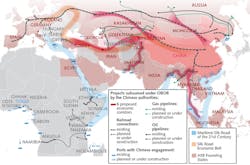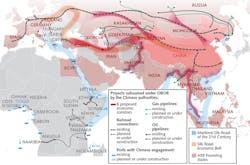China's B&R Initiative brings opportunities for photonics
When speaking at our 2017 Lasers & Photonics Marketplace Seminar, Bo Gu from BOS Photonics spent considerable time describing China's Belt and Road Initiative (B&R). As he said, "This is the official government policy—that means they will do it." Afterward, I was struck by the number of comments showing that the information had surprised many of the executives in the audience. The B&R is a sweeping, long-term plan by the Chinese government that will have many implications for international relations, global trade, manufacturing, the environment, and, yes, photonics.
The B&R, or One Belt, One Road (OBOR), is a development strategy and framework proposed by Chinese President Xi Jinping in 2013 that focuses on connectivity and cooperation among China and the rest of Eurasia. It consists of two main components, the land-based Silk Road Economic Belt and oceangoing Maritime Silk Road. Some estimates place potential total related investments from many countries at over $900 billion.
In May, Xi hosted a high-profile, two-day global forum about the plan. Although the G7 nation heads were not there, it still drew more than two dozen national leaders, prominent envoys from approximately 130 countries, and officials. China received support for most of its proposals during the meeting, although it failed to secure European endorsement of a planned statement on trade. European officials at the forum said the proposed trade statement omitted clauses on transparency and standards in tendering contracts.
Chas Freeman, senior fellow at Brown University's Watson Institute for International and Public Affairs, wrote an interesting analysis of the topic in November 2016. "The 'one belt, one road' initiative is partly a short-term measure to alleviate overcapacity in China's cement, steel and aluminum industries by conjuring up export markets for them. It will let Chinese manufacturing and construction companies continue for a while to do the sort of work abroad that is winding down at home. But, in the longer term, it is a strategy to use Chinese resources to tie Europe and Asia more closely to each other and to China. The added efficiencies of its planned railways, waterways, highways, pipelines, power grids, fiber optic cables, and air and sea ports respond to real market requirements and opportunities. Its institutional linkages will facilitate the investment necessary to realize these efficiencies." The B&R requires cooperation among over 70 countries in areas such as transportation, advanced manufacturing, infrastructure, and energy and natural resources—all areas where photonics technologies play crucial roles.
In his talk at the Seminar, Bo Gu saw many opportunities for lasers and photonics to play a role, and for advanced manufacturing technologies to help solve problems of resource limitations and environmental pollution. Germany in particular stands to benefit from this vast market for technological products and services, but U.S. companies such as Honeywell, GE, and Caterpillar are already accelerating efforts to participate.
Here are two resources I found most interesting: The Mercator Institute for China Studies has an excellent series of reports on the impact of B&R on Europe (www.merics.org/en/tags/one-belt-one-road); and China's official website on B&R (http://english.gov.cn/beltandroad).
About the Author

Conard Holton
Conard Holton has 25 years of science and technology editing and writing experience. He was formerly a staff member and consultant for government agencies such as the New York State Energy Research and Development Authority and the International Atomic Energy Agency, and engineering companies such as Bechtel. He joined Laser Focus World in 1997 as senior editor, becoming editor in chief of WDM Solutions, which he founded in 1999. In 2003 he joined Vision Systems Design as editor in chief, while continuing as contributing editor at Laser Focus World. Conard became editor in chief of Laser Focus World in August 2011, a role in which he served through August 2018. He then served as Editor at Large for Laser Focus World and Co-Chair of the Lasers & Photonics Marketplace Seminar from August 2018 through January 2022. He received his B.A. from the University of Pennsylvania, with additional studies at the Colorado School of Mines and Medill School of Journalism at Northwestern University.

